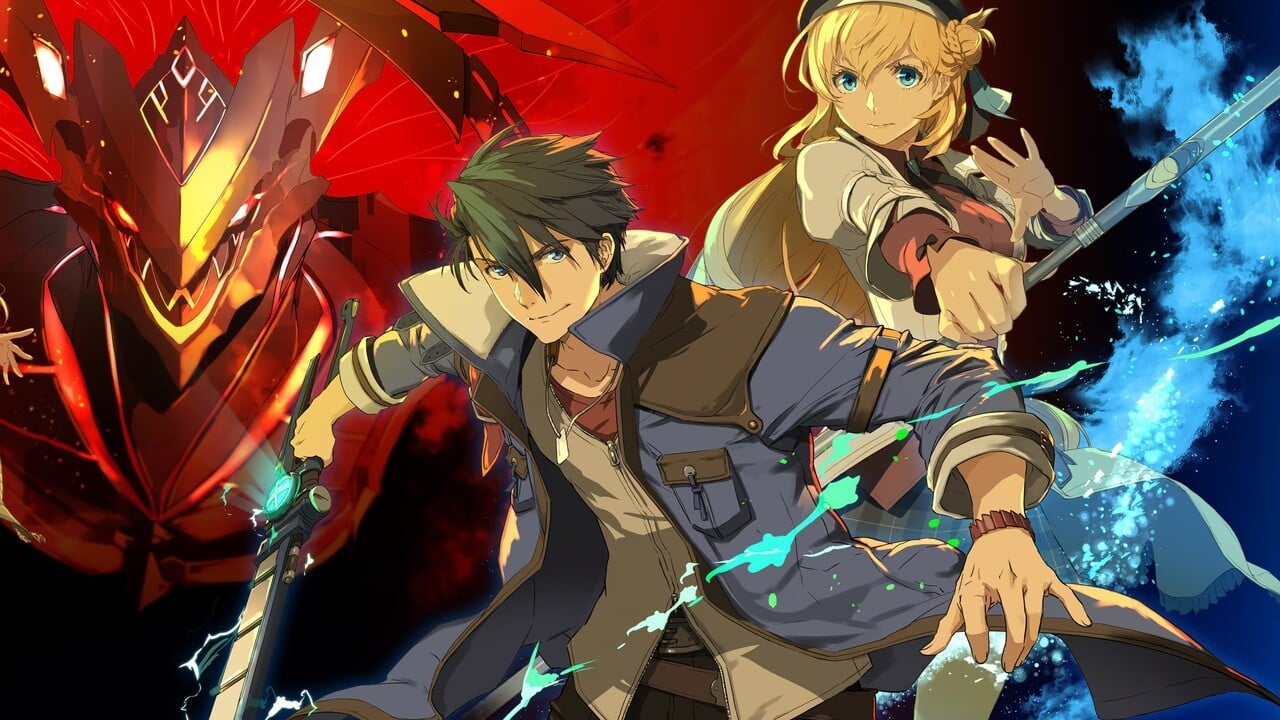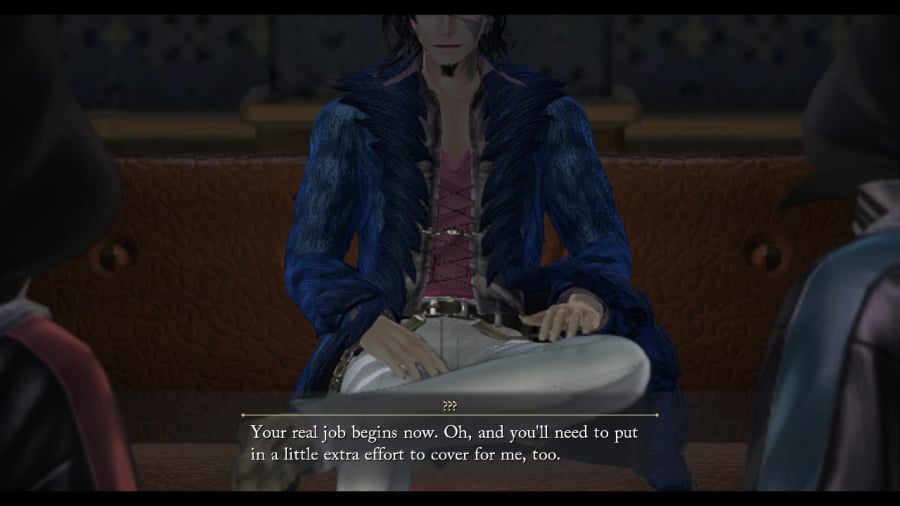

On Western shores last yast year, Falcom started a fresh arc in its long-running flagship franchise with The Legend of Heroes: Trails through Daybreak, breathing new life into the series while offering a great jump-in point for newcomers looking for a place to start. With the overall Trails series rapidly nearing the conclusion of the epic story it’s been building up for the last couple of decades, Falcom has now released The Legend of Heroes: Trails Through Daybreak II, allegedly the final release in this arc. This sophomore outing for Van and crew feels a little more uneven than its predecessor, but is ultimately a worthwhile new entry.
The plot picks up not too long after the previous game, starting once again with protagonist Van Arkride taking a midday nap on the couch in his office. He’s soon visited by his old friend Elaine from the Bracer Guild, who alerts him to reports of a new serial killer on the loose in Calvard. As the local Spriggan (a sort of private investigator), this would already be in Van’s wheelhouse, but there’s an additional detail that raises the stakes: the killer somehow has their own Grendel form, which was previously thought to be unique to Van. The two thus set out on the trail (heh) to track down the killer.

Suffice it to say, this is only the setup and a lot more happens later that expands the scope considerably and notably involves time-travel shenanigans. Although we still enjoyed the narrative, particularly the depth of the characterisation, it does feel a little more oddly paced than its predecessor and relies too much on the time travel elements to give the protagonists a ‘do-over’ almost anytime something goes wrong.
And while this isn’t necessarily a bad thing, important characters and plotlines from previous Trails releases feature here, which takes away from the nicely self-contained and more newcomer-friendly approach of the previous entry. Even given the contributions of the older cast members, longtime fans of the franchise may also be frustrated by the lack of progression for the overarching series plot—in many ways, this is very much a ‘bottle episode’ or side story that doesn’t do much to alter the status quo.
Considering that the end of the Trails series as a whole is quickly coming into sight, it can feel a little disappointing to play through a release that’s content to idle in place instead of answering some longstanding questions.

Combat follows an expanded version of the system introduced with the previous entry, smartly mixing both live-action and turn-based elements. When you first encounter enemies in the field, you can opt to simply beat the tar out of them with your weapon of choice, and new additions like quick-fire arts and cross attacks with other party members give you a few other options. Still, this action combat is less of a focus than the turn-based system, which you can always trigger with the tap of a button.
Once in turn-based mode, things unfold more like you’d expect out of a typical Trails game, with plenty of tactical options to demolish your foes. A redesigned timeline at the top of the screen details things like who moves next or how long a given ability’s cast time will take, and each character has a variety of Arts and Crafts to take advantage of elemental weaknesses and debuffs.
Positioning really matters here, so when a character takes their turn, they can move freely within a set range to evade attacks enemies are winding up for while setting up their own counterattacks that can garner bonuses for being inflicted from the side or behind.

Due to its depth, combat is the highlight here, though the ‘action’ side could have a little more meat to it. The new additions certainly help to flesh it out, but it doesn’t feel like a viable alternative to the turn-based combat for anything stronger than the common trash mob. Even if it clearly isn’t meant as the primary means of combat, we would’ve liked a little more effort put into making it more engaging; the current system is still awkward and we found ourselves using it less over time as its shallowness became more apparent.
One area in which you’ll get plenty of opportunity to put this system through its paces is a new side mode called the Marchen Garten, a procedurally-generated dungeon that takes after the True Reverie Corridor from Trails into Reverie.
Here, you’re tasked with taking a party of any four unlocked characters and working your way through floors with randomised objectives, such as breaking a certain number of objects or defeating specific enemies, that culminate in a tough boss fight. Good performance gives you extra cracks at an in-game gacha with rewards like new cosmetics and, importantly, upgrades for crafts and S-crafts.

We appreciate what Marchen Garten is going for—a side mode like this feels like it absolutely belongs in a Trails game—but the execution is lacklustre. It doesn’t take very long for the repetitive nature to make progression feel like a grindy slog, and the rewards you’re often given for your troubles rarely feel like they justify the effort to get them. Sure, it’s good for grinding your characters into peak shape, but there’s a lingering sense of ‘missed opportunity’. Marchen Garten feels like padding— not inherently bad, but hopefully Falcom will keep iterating on what it was trying here for future games.
Apart from the combat and the core gameplay loop, there are also a variety of fun minigames and side activities to engage in as a sort of palate cleanser. Things like a hacking minigame with Mare for opening special chests or a fishing minigame anywhere there’s running water help to break up the gameplay loop a bit and introduce some fun distractions that can also net you some tasty rewards. While none of these minigames overstay their welcome and they’re rarely forced upon you as part of the core progression, we appreciated what they added.

Visually, Trails Through Daybreak II borrows a lot of assets from its predecessor, but there are some improvements evident in the generally smoother and flashier battle animations. And though the environments and models overall look decent (if a bit simplistic), this entry falls into the same pit of having text that’s way too small for the Switch’s portable screen, to the extent that certain letters will simply not display properly. Considering how heavily it relies on lengthy, text-heavy cutscenes and detailed tinkering with character loadouts, we’d advise those of you with poorer eyesight to play primarily with the Switch docked.
That said, even if the text clearly isn’t optimised well for the Switch, the underlying game engine still runs cleanly on the humble hardware. Frame drops were minimal and mostly unnoticeable in our experience, while load times are kept to a minimum and are reasonable when they occur.
As for the music, Trails Through Daybreak II features a welcome mixture of the expected bombastic rock tracks with more downbeat jazz and funk tunes that help to give things more atmosphere. It’s not a soundtrack that demands a thorough listen in the same way that some of the best Persona OSTs do, but overall it’s tough to be disappointed by the variety and quality that the composers delivered here.
Conclusion
Trails Through Daybreak II doesn’t feel nearly as refreshing as its predecessor, but it’s still a solid entry in the long-running series that ticks the necessary boxes (legible text aside). Though its story isn’t all that exceptional, the combat is as rewarding as ever and new gameplay features like the Marchen Garten help to make this feel distinct and worthwhile. And while we wouldn’t necessarily suggest that this is a great starting point for newcomers, series fans will find lots to love here, even if it won’t be topping many lists as a series favourite.

On Western shores last yast year, Falcom started a fresh arc in its long-running flagship franchise with The Legend of Heroes: Trails through Daybreak, breathing new life into the series while offering a great jump-in point for newcomers looking for a place to start. With the overall Trails series rapidly nearing the conclusion of the epic story it’s been building up for the last couple of decades, Falcom has now released The Legend of Heroes: Trails Through Daybreak II, allegedly the final release in this arc. This sophomore outing for Van and crew feels a little more uneven than its predecessor, but is ultimately a worthwhile new entry.
The plot picks up not too long after the previous game, starting once again with protagonist Van Arkride taking a midday nap on the couch in his office. He’s soon visited by his old friend Elaine from the Bracer Guild, who alerts him to reports of a new serial killer on the loose in Calvard. As the local Spriggan (a sort of private investigator), this would already be in Van’s wheelhouse, but there’s an additional detail that raises the stakes: the killer somehow has their own Grendel form, which was previously thought to be unique to Van. The two thus set out on the trail (heh) to track down the killer.

Suffice it to say, this is only the setup and a lot more happens later that expands the scope considerably and notably involves time-travel shenanigans. Although we still enjoyed the narrative, particularly the depth of the characterisation, it does feel a little more oddly paced than its predecessor and relies too much on the time travel elements to give the protagonists a ‘do-over’ almost anytime something goes wrong.
And while this isn’t necessarily a bad thing, important characters and plotlines from previous Trails releases feature here, which takes away from the nicely self-contained and more newcomer-friendly approach of the previous entry. Even given the contributions of the older cast members, longtime fans of the franchise may also be frustrated by the lack of progression for the overarching series plot—in many ways, this is very much a ‘bottle episode’ or side story that doesn’t do much to alter the status quo.
Considering that the end of the Trails series as a whole is quickly coming into sight, it can feel a little disappointing to play through a release that’s content to idle in place instead of answering some longstanding questions.

Combat follows an expanded version of the system introduced with the previous entry, smartly mixing both live-action and turn-based elements. When you first encounter enemies in the field, you can opt to simply beat the tar out of them with your weapon of choice, and new additions like quick-fire arts and cross attacks with other party members give you a few other options. Still, this action combat is less of a focus than the turn-based system, which you can always trigger with the tap of a button.
Once in turn-based mode, things unfold more like you’d expect out of a typical Trails game, with plenty of tactical options to demolish your foes. A redesigned timeline at the top of the screen details things like who moves next or how long a given ability’s cast time will take, and each character has a variety of Arts and Crafts to take advantage of elemental weaknesses and debuffs.
Positioning really matters here, so when a character takes their turn, they can move freely within a set range to evade attacks enemies are winding up for while setting up their own counterattacks that can garner bonuses for being inflicted from the side or behind.

Due to its depth, combat is the highlight here, though the 'action' side could have a little more meat to it. The new additions certainly help to flesh it out, but it doesn't feel like a viable alternative to the turn-based combat for anything stronger than the common trash mob. Even if it clearly isn’t meant as the primary means of combat, we would’ve liked a little more effort put into making it more engaging; the current system is still awkward and we found ourselves using it less over time as its shallowness became more apparent.
One area in which you’ll get plenty of opportunity to put this system through its paces is a new side mode called the Marchen Garten, a procedurally-generated dungeon that takes after the True Reverie Corridor from Trails into Reverie.
Here, you’re tasked with taking a party of any four unlocked characters and working your way through floors with randomised objectives, such as breaking a certain number of objects or defeating specific enemies, that culminate in a tough boss fight. Good performance gives you extra cracks at an in-game gacha with rewards like new cosmetics and, importantly, upgrades for crafts and S-crafts.

We appreciate what Marchen Garten is going for—a side mode like this feels like it absolutely belongs in a Trails game—but the execution is lacklustre. It doesn’t take very long for the repetitive nature to make progression feel like a grindy slog, and the rewards you’re often given for your troubles rarely feel like they justify the effort to get them. Sure, it’s good for grinding your characters into peak shape, but there’s a lingering sense of 'missed opportunity'. Marchen Garten feels like padding— not inherently bad, but hopefully Falcom will keep iterating on what it was trying here for future games.
Apart from the combat and the core gameplay loop, there are also a variety of fun minigames and side activities to engage in as a sort of palate cleanser. Things like a hacking minigame with Mare for opening special chests or a fishing minigame anywhere there’s running water help to break up the gameplay loop a bit and introduce some fun distractions that can also net you some tasty rewards. While none of these minigames overstay their welcome and they’re rarely forced upon you as part of the core progression, we appreciated what they added.

Visually, Trails Through Daybreak II borrows a lot of assets from its predecessor, but there are some improvements evident in the generally smoother and flashier battle animations. And though the environments and models overall look decent (if a bit simplistic), this entry falls into the same pit of having text that’s way too small for the Switch’s portable screen, to the extent that certain letters will simply not display properly. Considering how heavily it relies on lengthy, text-heavy cutscenes and detailed tinkering with character loadouts, we’d advise those of you with poorer eyesight to play primarily with the Switch docked.
That said, even if the text clearly isn’t optimised well for the Switch, the underlying game engine still runs cleanly on the humble hardware. Frame drops were minimal and mostly unnoticeable in our experience, while load times are kept to a minimum and are reasonable when they occur.
As for the music, Trails Through Daybreak II features a welcome mixture of the expected bombastic rock tracks with more downbeat jazz and funk tunes that help to give things more atmosphere. It’s not a soundtrack that demands a thorough listen in the same way that some of the best Persona OSTs do, but overall it’s tough to be disappointed by the variety and quality that the composers delivered here.
Conclusion
Trails Through Daybreak II doesn’t feel nearly as refreshing as its predecessor, but it’s still a solid entry in the long-running series that ticks the necessary boxes (legible text aside). Though its story isn’t all that exceptional, the combat is as rewarding as ever and new gameplay features like the Marchen Garten help to make this feel distinct and worthwhile. And while we wouldn’t necessarily suggest that this is a great starting point for newcomers, series fans will find lots to love here, even if it won’t be topping many lists as a series favourite.






